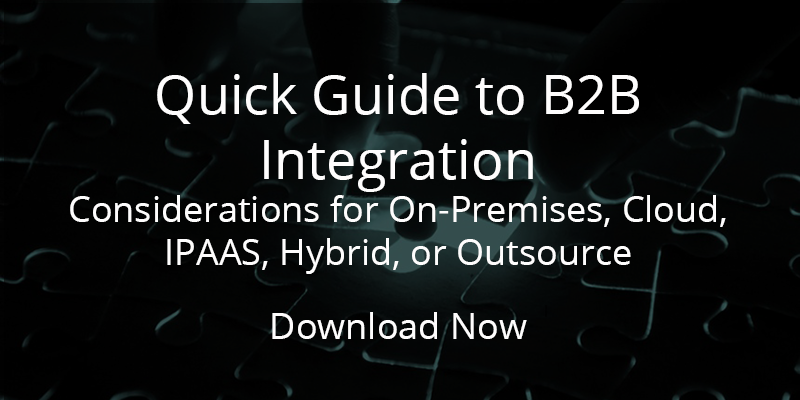
The modern business landscape is complex. Supply chains present challenges, as do intricate partner networks. Then, there are the challenges of collaborating with vendors, suppliers, customers, and corporate affiliates.
B2B integration suites are tools that can help you make sense of this chaos. However, the utility of these suites has not always been as high as it is today. This article explores how B2B integration suites have evolved over time, including how they will continue to play a role in future data integration needs.
B2B Integration Suites: What Methods Were Used in the Earliest Stages?
Over the past few decades, enterprise integration has leveraged a number of integration methodologies.
MFT: Managed File Transfer (MFT) is one of the earliest methods of integrating information. During MFT, an application writes a file that the other application reads, and vice versa. The two applications must “negotiate” such aspects as file format, standards, location, privileges and read/write coordination before any data is transferred.
Shared Database:Another approach that has stood the test of time is the Shared Database technique. Through this approach, software applications use a common database to share information with one another.
The Remote Procedure Invocation (also known as Remote Procedure Call, RPC) allows an application to expose some functionality through a well-defined interface. Other applications can invoke such functionality (hence the name) remotely. Before the advent of SOA, CORBA was a popular RPC method.
Message-Based: Yet another integration process is Message-Based. This approach relies upon all applications connecting to a unified messaging bus. They exchange data and invoke functionalities via messaging. Thanks to this method, applications can be decoupled, and there is high-speed, asynchronous/synchronous program-to-program communication with delivery message-oriented middleware that is reliable and service-oriented architecture based on web services and an enterprise service bus.
In the early days of integrating information within the enterprise, in-house middleware was a popular and effective method to meet integration needs. Companies would develop integration middleware in-house in an ad hoc manner using proprietary protocols. They created monolithic systems that utilized point-to-point connectivity between each application. As a result, companies solved integration problems while creating larger business functionality issues.
The Next Step in the Evolution
What happened as more software systems were added to the enterprise landscape? The homegrown middleware system could not handle the complexity.
Enterprise Application Interchange (EAI) and EDI. EAI is a dedicated integration middleware framework that centralizes and facilitates the infrastructure’s integration requirements. It utilizes hub-and-spoke architecture.
Unlike point-to-point integration, the hub-and-spoke architecture allows the loose coupling of applications. As the hub is the central component, you avoid the need to maintain multiple configuration repositories. The hub connects the applications using a spoke (an adapter for each software system).
However, hub-and-spoke architecture has its limitations. A centralized hub can act as a single point of failure, and under heavy loads, the hub creates bottlenecks. EAI was difficult to adopt as a common integration middleware because it was generally built with proprietary technologies and only focused on a particular business domain.
Bus architecture aimed to address the weaknesses of hub-and-spoke architecture. In the bus architecture method, the centralized messaging bus can be scaled horizontally. But distributed integration tasks become more complicated, which increases the maintenance and troubleshooting burden on the IT department. Again, EAI’s proprietary nature and the non-standard bus impeded this architecture’s popularity.
Entering the 21st Century: What Does Integration Look Like Today?
At the beginning of the previous decade, service-oriented architecture (SOA) became more prevalent. SOA is a collection of services that communicate with one another and must be connected so they can pass data to one another or coordinate activities. This architectures is by no means a new idea; CORBA is one of the earliest forms of SOA.
SOA has come into play as web services, which has become the primary way of implementing software solutions. SOA has revolutionized the way companies approach software implementation, and SOA has been widely adopted. That means that businesses need infrastructure that will connect various services so they can communicate with one another.
Thanks to the rise of SOA, a new architectural concept has come to the fore: the enterprise service bus (ESB). The ESB is a middleware tool that distributes work among connected components of an application. ESBs provide a uniform way of moving work and offer applications the ability to connect to the bus and subscribe to messages based on structural and business policy rules.
Here is what ESBs generally do:
- Modify message content, direction, destination, and protocols based on message flow configurations
- Adds new service interfaces to existing systems
- Converts one protocol to another (for example, JMS to HTTP)
- Supports enterprise integration patterns
- Applies caching, throttling, and security to ensure the highest quality of service
- Connects to legacy and proprietary systems
- Driven by configurations, not code
- Features extension points so that ESBs can integrate with custom protocols or proprietary systems
The Pros and Cons of ESBs
ESBs have been highly successful; they have become the backbone of many companies’ IT landscapes. However, ESBs have limitations, especially given some major developments.
Social media, mobile devices, Big Data, and the cloud have all left a significant impact on enterprise IT. They require external interactions, which is the opposite of what SOA and ESBs are designed to do. They are meant for internal interactions.
The problem for firms is that now social media, mobile devices, Big Data, and the cloud are fixtures in the business landscape. There is no going back and returning to simpler times. How can businesses solve the problems posed by SOA and ESBs’ limitations?
Application programming interfaces (APIs) are a good compromise. APIs are a set of routines, protocols, and tools to build software applications; they specify how software components should interact with one another.
“APIs are a good compromise to deal with the advent of social media, the cloud, mobile devices, and Big Data.”
Managed APIs go a long way in overcoming the shortcomings of SOA and ESBs. They enable users to subscribe and access the API through a self-service mechanism. In addition, you can monetize APIs, creating another revenue stream for your company.
The Pros and Cons of APIs
While APIs are useful, there are problems they simply do not solve (a similarity they share with SOA and ESBs).
For a start, they do not integrate. APIs expose business functionality to partners in an orderly manner. They do not solve any issues that disparate systems and technologies present (which can be myriad).
“APIs don’t integrate; they expose business functionality to partners in an orderly way.”
You still need underlying architecture when using APIs. For an organization to offer an API, it would have to have an implementation of the services and the connections between the required systems and services. That necessitates an integration backbone such as an ESB, upon which the API layer would sit.
Finally, SOA frameworks simply cannot support API management. Although many vendors have tried to manipulate SOA frameworks, their efforts lead to unstable and disconnected frameworks.
What Is the Best Solution?
With integration, what are your options? In today’s IT landscape, you are spoiled for choice. However, that does not mean that all of those choices are effective or efficient.
You can purchase several point solutions that support APIs and middleware. That approach is expensive, though. It is also more difficult to manage because you lack a central console to control each tool.
A B2B integration suite can support these, in addition to an EDI solution and file exchange in one place. You are only managing one solution, saving time and money. A B2B integration suite increases visibility; you can see everything you need in one place, as opposed to having to check multiple point tools.
B2B integration suites are built for today’s business technology landscape. They allow for flexible integration that does not compromise the integrity of an application. Modern applications are characterized by two things: each application has an internal data model and each integration offers the possibility of further integrations. A B2B integration suite integrates information without weakening the application through further integration.
“A B2B integration suite increases visibility; you can see everything in one place.”
Integration has come a long way in the past few decades. While there are many tools on the market to ensure integration goes smoothly and efficiently, a B2B integration suite is often the best choice because it saves time and money while boosting data visibility. To learn more about your integration options, contact us today.



